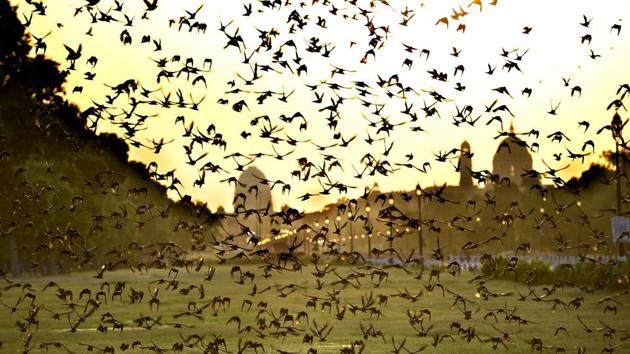Here’s something for you to do this Sunday: Birding
Since the lockdown began, and people started spending all their time at home, there’s been a huge upsurge of interest in birding.
I have been working largely from home for the past two weeks. Every evening, at around 6pm, I head up to the terrace, where I spend 15 minutes watching the Rosy Starlings that are staging in Delhi ahead of their north-western journey to Europe and Central Asia. I haven’t seen any murmurations, but some of the flocks are large. On Friday evening, I saw one with a few hundred birds. And then I got back to work.

Birding is one of the few outdoorsy things you can still do during the lockdown — even in a Mumbai apartment with no balconies (one of my colleagues in Mumbai wrote a fascinating article on how people are feeling the pinch of this now; over the past two decades, developers in the city decided that balconies were a luxury and decided people would happily give them up for a small extra room).
Since the lockdown began, and people started spending all their time at home, there’s been a huge upsurge of interest in birding. And people are realising that there are a lot of birds around. One of my friends, a recent convert, sends me photographs taken in his garden, asking for bird IDs. They are common birds, but it is likely he is seeing them for the first time. Just like I did around 14 years ago.
I started birding in 2006 when my son (then four years old) picked up an interest in birding. And I suddenly started seeing birds — they’d always been there; I just hadn’t noticed them before. I still don’t see all of them. On Sunday morning for instance, I was helping my son out with a concept in differentiation when he pointed out a Blyth’s Reed Warbler on the moringa tree outside his window — it was on its way back to Eastern Europe and Central Asia. The math session didn’t go very well.
Delhi is an especially good place to bird — although the best bird picture of the lockdown is from Mumbai (and was taken by HT’s own photographer, Pratik Chorge, in Navi Mumbai).
Delhi has the second highest number of bird species in a city after Nairobi (Kenya) where you can sometimes see Marabou Storks nesting on the top of street lights. The closest relative of the Marabou in India, the Greater Adjutant Stork is a common sight in Guwahati’s urban landscape (especially where there is garbage). Even in the heart of Delhi, near the HT office, I’ve seen Indian grey hornbills, and, back when my office was a corner room at the 16th floor, a pair of Egyptian vultures that were nesting on the terrace of an adjoining building. From that office, on clear winter days, I’ve also seen the Delhi zoo’s resident population of great White Pelicans — they live in an open-air aviary and do not leave because they are well fed — soaring on thermals. Now, I’m grounded in a first-floor office in the same building, and the only birds I see (and hear, more often than I see) are the rose-ringed parakeets in the solitary tree outside the window.
Delhi is also a good place to bird because it, Gurugram, and parts of Haryana and Rajasthan lie along the Central Asian Indian flyway, which is an important migration route, largely for water birds.
So, what birds can you expect to see at home?
If you have a garden, you can see most of the garden birds — barbets of two kinds, pigeons of two kinds, doves of two kinds too, the Rufous Tree-pie, the Indian Silver Bill, two species of bulbuls, the Common Tailor Bird, the House Sparrow, three kinds of starlings, the Common Crow, the Indian Grey Hornbill, the Purple Sunbird, the Oriental Magpie Robin, the Shikra, babblers of two kinds (maybe three), the Black Kite, and a few others.
Even a few plants in a balcony are bound to attract a few of these birds. If you are lucky and have an old tree in or near your house, you may even be able to see owlets, a Barn Owl, maybe even a Golden Oriole.
And then, of course, you could look skywards. I’ve spotted ibises of two kinds and an Oriental Honey Buzzard flying over the house; the son has spotted a Booted Eagle, an Egyptian Vulture, and a flock of Common Cranes. In the winter months, we see ducks, sometimes geese.
We are locked down. The birds are still free.






